ALBERTA
History

History

Popular destinations CANADA
| Alberta | British columbia | Manitoba |
| New brunswick | Newfoundland and labrador | Northwest territories |
| Nova scotia | Nunavut | Ontario |
| Prince edward island | Quebec | Saskatchwan |
| Yukon |
History
Alberta before the arrival of the Europeans
The Canadian province of Alberta has a history stretching back thousands of years to prehistoric times. Written sources are unfortunately only available since the arrival of the Europeans in the 18th century.
The ancestors of today's First Nations (native Indian population) lived at least 8,000 years BC. in Alberta. Southern tribes, generally prairie Indians such as the Blackfeet, were made up of four different tribes: the Pikuni or Piegan, the Northern Pikuni, the Siksika, and the Blood of Kainai Indians lived in the borderlands of Northern Montana and Southern Alberta. More northerly tribes, such as the Woodland Cree and the Chipewyan, lived in wooded areas.
In a much later period, these original inhabitants mixed with French fur traders and thus created a new culture, that of the mestizos. Mestizos first lived mainly east of Alberta, but hunted by European white settlers, many mestizos settled in Alberta.
It is believed that in the period 950-1250 the large prairie areas became depopulated due to a period of drought. After this dry period, the prairies became populated again, now with tribes from all over North America, including Comanches, Shoshones, Sioux, Assiniboine and Crow. In addition to frequent tribal wars, there were also periods of cooperation between these tribes in semi-permanent alliances.
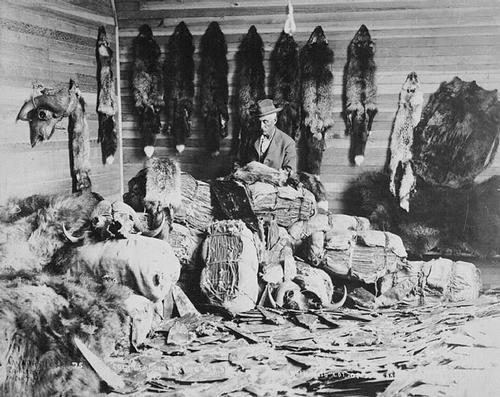 Late 19th century fur trader in Fort Chipewyan, Alberta Photo: Public domain
Late 19th century fur trader in Fort Chipewyan, Alberta Photo: Public domain
Alberta after the arrival of the Europeans
The first European to reach Alberta was probably a Frenchman Pierre la Vérendrye or one of his sons. La Vérendrye reached the present-day neighboring province of Manitoba mainly through a system of rivers in 1730, founded forts there and negotiated in person with the Indians about the fur trade. Around 1750, the best furs were traded by La Véendrye outside of the Hudson's Bay Company (Canada's oldest company), a London-based company founded in 1670 that dominated the fur trade in British North America for centuries on the rivers flowing into Hudson Bay. .
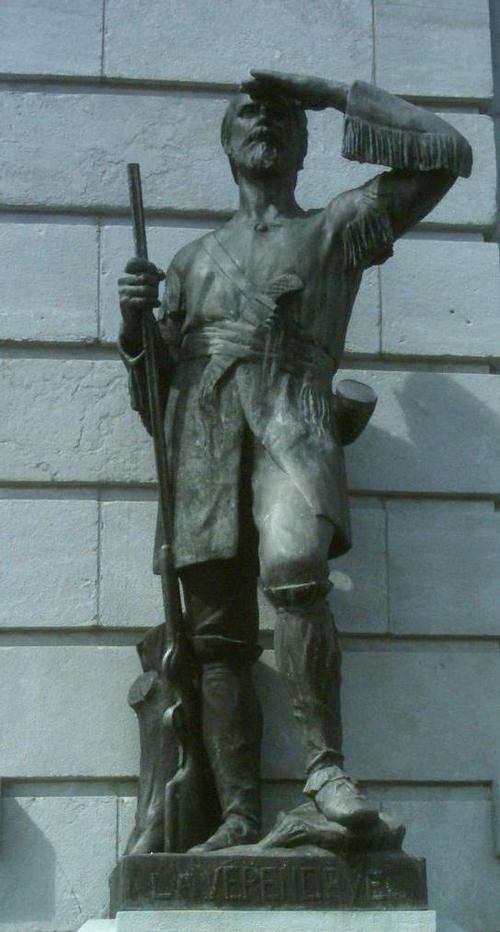 Pierre Gaultier de Varennes, sieur de La Vérendrye (1685-1749)Photo: Jean Gagnon CC 3.0 Unported no changes made
Pierre Gaultier de Varennes, sieur de La Vérendrye (1685-1749)Photo: Jean Gagnon CC 3.0 Unported no changes made
The first written source containing present-day Alberta was by fur trader Anthony Henday, who was in the Edmonton and Red Deer area in 1754-55. Other important early discoverers of Alberta were Peter Fidler, David Thompson, Peter Pond, Alexander MacKenzie and George Simpson. The first European settlement, Fort Chipewyan, was founded in 1788 by Alexander MacKenzie. This 'honor' is also disputed by Fort Vermilion, which was also founded in 1788.
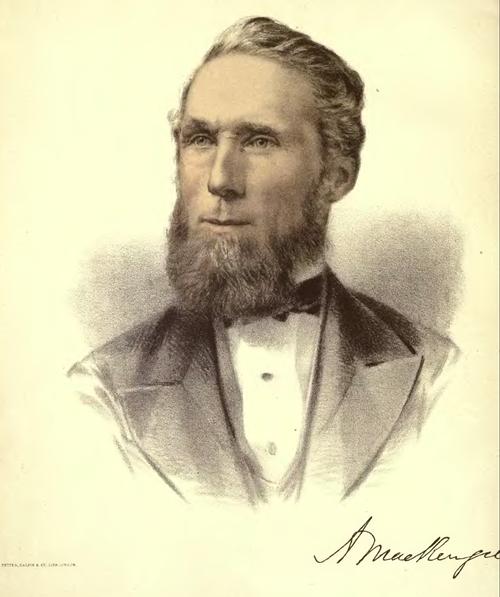 Alexander MacKenzie (1764-1820), explorer AlbertaPhoto: Public domain
Alexander MacKenzie (1764-1820), explorer AlbertaPhoto: Public domain
Alberta's earliest history is thus closely linked to the fur trade, and the first confrontation was between French and English fur traders, which had the character of a genuine fur war. Central and Southern Alberta, so-called Rupert's Land, were fully claimed by the Hudson's Bay Company in 1670. Rupert's Land was a huge area, about a third of what is now Canada. This monopoly was disputed by a French trade organization from Montreal, 'Coureurs des Bois', but after the Battle of Quebec in 1759 during the Seven Years' War between the English and the French, the Hudson's Bay Company gained a monopoly on the fur trade and was able to expand it indefinitely and maintain.
France was finally defeated after Quebec, and at the Peace of Paris in 1763 the French were more or less forced to cede all their possessions in Canada to the English, and the British-controlled area was renamed British North America. In the 1770s, competition for the Hudson's Bay Company resumed through the North West Company, a private company that focused mainly on the rivers and waters that did not end in Hudson Bay, but in the Pacific, for example. Many of Alberta's current cities once started out as a commercial networksettlement of the Hudson's Bay Company or the North West Company.
In 1821 the Hudson's Bay Company merged with the North West Company, but as early as 1870 the monopoly position of the new company was banned and any company could enter the fur market fail. Under the Rupert's Land Act of 1868, Rupert's Land and North-Western Territory was transferred to the Dominion of Canada on July 15, 1870 and was henceforth called Northwest Territories. The Dominion of Canada was formed by three British-North American provinces since July 1, 1867: the Province of Canada, split into the provinces of Ontario and Quebec, and the colonies of New Brunswick and Nova Scotia. The province of Manitoba was added in 1870, British Columbia in 1871 and Prince Edward Island in 1873.
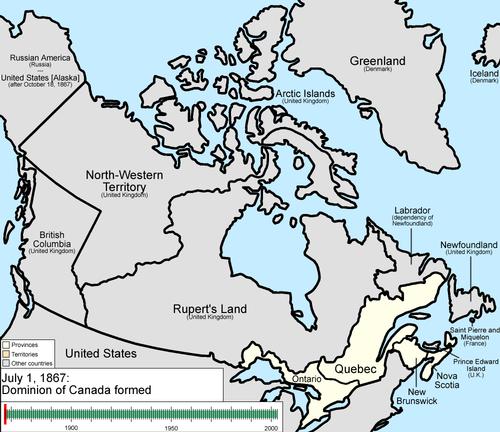 Provinces of Dominion of Canada in the period 1867-1870Photo: Public domain
Provinces of Dominion of Canada in the period 1867-1870Photo: Public domain
The economic struggles roughly paralleled the religious struggles between rival churches, including the Roman Catholic Church, Methodists, the Anglican Church of Canada, and several other Protestant denominations, who were trying to win over the Native American population. The first Roman Catholic missionary, Jean-Baptiste Thibault, arrived in Lac Saint Anne, Alberta in 1842, and founded the first permanent Roman Catholic mission there. The Methodist Robert Bundle founded a mission in 1847.
The year 1867 was the year of Canada's birth: The British North America Act proclaims the colonies of New Brunswick, Nova Scotia, Ontario, and Quebec as the Dominion of Canada. The area of present-day Alberta was added to the Dominion of Canada in 1870 with the aim of making it a white-run and managed agricultural area. To this end, the Canadian government negotiated through the so-called 'Numbered Treaties' with various Indian tribes. The Indians were offered land in exchange for transferring all claims to large tracts of other land. At the same time, the waning power of the Hudson's Bay Company brought American whiskey traders and hunters to Southern Alberta, disrupting the Native American way of life. In 1873 this led to the Cypress Hills Massacre in present-day Saskatchewan, in which 23 Nakota Indians were murdered by a group of American bison and wolf hunters. It was also during this time that whiskey was introduced to the Native Americans, and white hunters shot masses of bison, the primary food source for the prairie Indians. The Indians also suffered from diseases brought along by the Europeans and the outbreak of wars between Indian tribes was commonplace. This culminated in the 1870 Battle of Belly River between the Blackfeet Confederacy and the Cree Indians. It would later turn out that it had been the last major battle between Indians on Canadian soil.
To restore calm, the government established the North-West Mounted Police, the 'mounties', in 1873. 1904 continued under the name Royal Northwest Mounted Police and after a merger with the Dominion Police the current Royal Canadian Mounted Police. In July 1874, 275 mounties headed for Alberta, the legendary 'March West'. At the westernmost point, a new headquarters was set up at Fort MacLeod, in 1875 Fort Walsh was established in the Cypress Hills, and Fort Calgary, a police station to combat the illegal whiskey trade, which later became the important city of Calgary for Alberta. The Royal Canadian Mounted Police is currently about 15,000 strong.
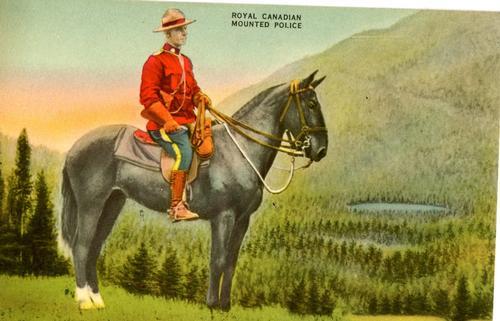
As the bison gradually disappeared from view in Western Canada, that place was soon taken by large cattle ranches, which were extremely suitable for this in this prairie environment. In Alberta, the first herd of cows was brought in by the black American cowboy John Ware in 1876, but the entire livestock and meat industry was in the hands of a few powerful men like Patrick Burns, who was also a period senator in the parliament of Alberta.
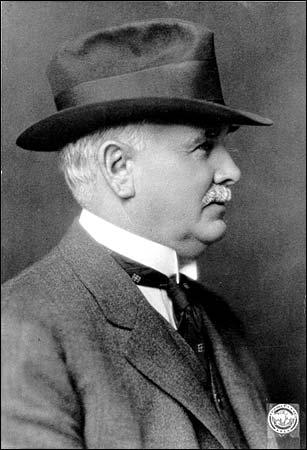 Patrick Burns (1856-1937)Photo: Public domain
Patrick Burns (1856-1937)Photo: Public domain
In 1882, the District of Alberta, named after Princess Louise Caroline Alberta, fourth daughter of the British Queen Victoria and wife of the Marquess of Lorne, who was then Governor General of Canada, was created as part of the Northwest Territories.
Meanwhile, the Canadian Pacific Railway was establishing rail lines towards the Pacific, and in 1885 the Trans-Canadian Railway was completed. Also in 1885 in what is now Saskatchewan and Alberta, the North-West Rebellion broke out between Mestizos and Indians on the one hand and Canadian government forces on the other. The insurgents eventually lost the battle and their leader Louis Riel was captured. After this battle, more and more settlers moved to Alberta, including 600,000 Americans around 1890. In order to attract even more settlers, advertising began in Europe, and large groups of Germans, Ukrainians and Scandinavians, among others, moved to Canada. and Alberta.
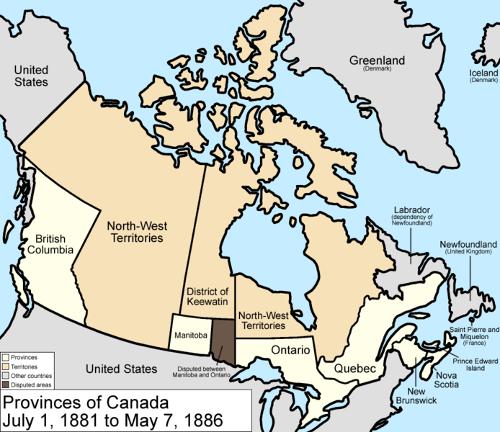 Canadian provinces and territories in the period 1881-1886 Photo: Golbez CC 3.0 Unported no changes made
Canadian provinces and territories in the period 1881-1886 Photo: Golbez CC 3.0 Unported no changes made
By the early 1900s, Alberta was still just a district of the North-West Territories, but local leaders lobbied fiercely for provincial status. But the Prime Minister of the Territories, Frederick Haultain, was also strongly in favor of a provincial division of the West, but he opted for one large province called Buffalo. The Canadian Prime Minister at the time, Wilfrid Laurier, did not want that because a Buffalo-like province would become too much of a competitor for Ontario and Quebec. He proposed and eventually it would become a two-provinces plan: on September 1, 1905, Alberta, with its capital Edmonton, and Saskatchewan, became Canadian provinces.
The first Prime Minister of Alberta would become the Liberal Alexander Rutherford, he led the province from 1905 to 1910, the Liberals remained in power until 1921. The new province had a population of 78,000 at the beginning of the 20th century, but the area lacked infrastructure, schools, and medical facilities. In addition, Ottawa had control of its natural resources until 1930, severely curtailing the province's economic development. This would continue to pose problems well into the 20th century between the government of Alberta and the national government in Ottawa. Meanwhile, Calgary was not amused that Edmonton had been named the capital of the new county, and became all the rage when the University of Alberta was given over to Strathcona, a suburb annexed by Edmonton in 1912.
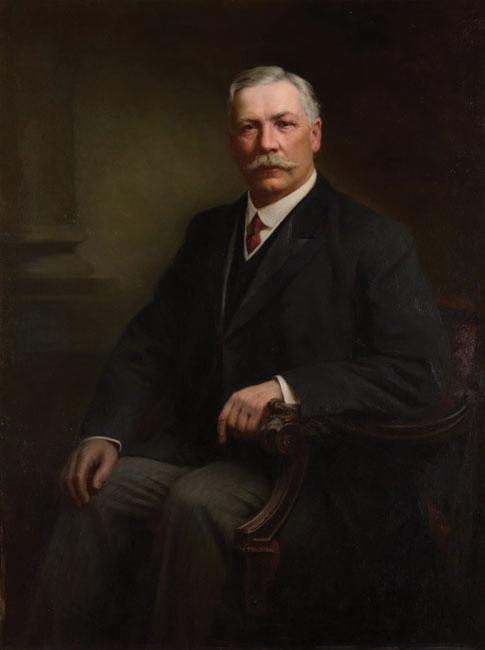 Alexander Cameron Rutherford (1857-1941), first Prime Minister of Alberta Photo: Public domain
Alexander Cameron Rutherford (1857-1941), first Prime Minister of Alberta Photo: Public domain
Attracted by cheap land and high wheat prices, more and more people migrated to the new province, by 1914 the population had already risen to 470,000. Important provincial political parties at that time became the 'agricultural' parties United Farmers of Alberta (UFA) and the Progressive Party of Canada, a national party. John E. Brownlee led the UFA to a majority in the provincial parliament after the elections in 1926 and 1930, and in 1930 managed to transfer control of natural resources from central government to provincial government. After a private scandal and economic setback, including plunging wheat prices, the UFA disappeared from the political scene in 1934. John Lineham (1861-1913), Western Canada's first oiler, co-founded in February 1901 with George Leeson and engineer Allan Patrick established the Rocky Mountain Development Company. They were convinced there was money to be made from oil and later that year began drilling for oil near Cameron Lake, now located in Waterton Lakes National Park. The trio succeeded in extracting a maximum of 300 barrels per day, but this oil well already dried up in 1904.
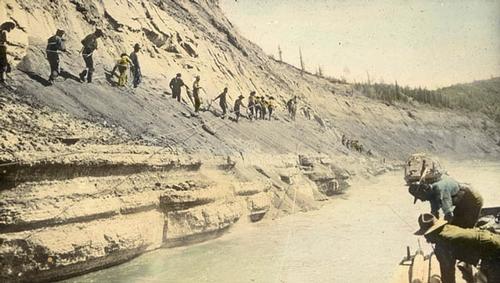 Athabasca Tar Sands circa 1900Photo: Public domain
Athabasca Tar Sands circa 1900Photo: Public domain
In 1914 oil was found again in Alberta, now south of Calgary in Turner Valley, at a depth of about 900 meters. For a long time, Turner Valley remained the largest gas and oil producer in the worldThe British Empire did not yet generate much income, but it did have a positive influence on the development of Calgary, which until then had mainly been the center of the meat industry in Canada and was not nicknamed 'cowtown' for nothing. It was not until the opening of a large oil field at Leduc, about 20 km south of Edmonton, for oil to become really important to the Alberta and Canadian economies. In 1948 oil was produced at Redwater, in 1956 the largest field to date, Pembina Field, west of Edmonton. Other fields were discovered east of Grande Prairie in central Alberta. In 1991, the fields of Alberta produced 81% of all crude oil in Canada, from then on, however, the quantities extracted decreased steadily. Oil exploration also led to the discovery of large gas fields, including at Picher Creek in the southeast and at Medicine Hat in northwestern Alberta.
The tar sands in the Athabasca River valley north of Fort McMurray in northeastern Alberta, contains a tremendous amount of oil, after Saudi Arabia the largest amount in the world. The first oil mill to extract oil from the tar sands was opened in 1967, the second in 1978. In 1991, the factories together produced 100 million barrels of oil. Politically important to Alberta was the 1932 foundation of the Social Credit Movement under led by William Aberhart, 'Bible Bill', which in 1935 created a political party, the Social Credit Party. The fundamentalist, God-fearing Aberhart denounced the modern materialist world and wanted everyone to take advantage of the increasing purchasing power. To achieve this, Aberhart wanted to give each man and woman $ 25 a month in the form of a so-called 'social credit'. Almost everyone was against this idea, which in the end would never be implemented, but unsurprisingly, Aberthart's Social Credit Party won by far in the 1935 parliamentary elections. The Social Credit Party remained in power until 1971 and won nine consecutive elections. Aberhart was Alberta's seventh Prime Minister from 1935 to 1943.
 William Aberhart (1878- 1943), seventh Prime Minister of Alberta Photo: Public domain
William Aberhart (1878- 1943), seventh Prime Minister of Alberta Photo: Public domain
Aberthart was succeeded in 1943 by his student Ernest C. Manning, and under him the Social Credit Party remained in power until 1968.
In the mid-1980s, the Social Credit Party was replaced by the Social Credit Party. son of Manning, Preston Manning, transformed into the Reform Party of Canada.
Alberta's contribution to World War II was substantial. In Alberta itself, POW and internment camps were set up in Lethbridge, Medicine Hat, Wainwright and Kananaskis Country. Moreover, in Alberta, in addition to a number of military training facilities, there were a large number of airfields of the British Commonwealth Air Training Plan. Many thousands of men, and later women, volunteered in the Royal Canadian Navy, the Royal Canadian Air Force and the Canadian Army and parts of the army such as the Loyal Edmonton Regiment, the Calgary (Tank) Regiment and the Calgary Highlanders fought for freedom in Europe.
By 1942, many Japanese from British Columbia, (Alberta itself had populations of Japanese in Raymond and Hardieville), sent to internment camps in Southern Alberta. The intention was that these Japanese would emigrate to Japan after the war, but not much of it came to pass and at this time the Japanese are completely assimilated into the population of Alberta.
Important for the opening up of all Canadian Provinces marked the completion in 1962 of the Trans-Canada Highway. In 1971, the conservatives of Peter Lougheed's Progressive Conservative Association of Alberta, often referred to as the Progressive Consevative Party of Alberta, put an end to the decades-long governance of the Social Credit Party and have been supplying Alberta Prime Minister Peter Lougheed (1971-1985) ever since., Don Getty (1985-1992), Ralph Klein (1992-2006), Ed Stelmach (2006-2011), Alison Redford (2011-2014), Dave Hancock (2014) and Jim Prentice (2014-....), since September 15, 2014, the 16th Prime Minister of Alberta. The Progressive Conservative Association of Alberta is currently the longest-serving party in Canada's history at the provincial level of government.
 Jim Prentice, 16th Prime Minister of AlbertaPhoto: Dave Cournoyer CC 2.0 Generic no changes made
Jim Prentice, 16th Prime Minister of AlbertaPhoto: Dave Cournoyer CC 2.0 Generic no changes made
Important to Alberta's tourism and economy was the organization of the 15th Calgary Winter Olympics in 1988.
In June 2013, after a period of heavy rains, Alberta was hit by devastating floods and mudslides, and rivers such as the Bow, Elbow, Highwood and Oldman burst their banks. Tens of thousands of 'Albertans', especially in and around Calgary, were forced to leave their homes. Roads and bridges were washed away in southern Alberta, the Trans-Canada Highway was cut off, and the villages of Banff and Canmore were cut off from the outside world.
On August 9, 2014, an area 75 km from the town was Sylvan Lake, near Red Deer and exactly halfway between Edmonton and Calgary, was hit by an earthquake measuring 4.3 on the Richter Scale. The previous very noticeable earthquake (3.6 on the Richter Scale) was already dated November 12, 2007 near Spuce Grove, just west of Edmonton. The heaviest earthquake in the last 40 years, 4.8 on the Richter Scale, was on May 14, 1978, southwest of Jasper. Between 1918 and 2009, 819 earthquakes were reported in Alberta, but they caused little damage and no casualties.
 Alberta was hit by floods in June 2013Photo: Ryan L,C. Quan CC 3.0 Unported no changes made
Alberta was hit by floods in June 2013Photo: Ryan L,C. Quan CC 3.0 Unported no changes made
At the beginning of January 2015, Prime Minister Jim Prentice announced that due to the plummeting oil prices from November 2014, the projected budget surplus would fall from $ 1.5 billion in 2015 to a budget deficit of $ 500 million. Since the summer of 2014, the price of a barrel of oil had fallen from 100 US dollars to 50 dollars in early January 2015. In 2019, there have been climate protests from young people in particular against what they say is the overshadowed importance of oil to Alberta.
See also the history of Canada on TheWorldOfInfo.
Sources
Canada
Cambium
Canada
Lonely Planet
Hempstead, Andrew / Calgary
Avalon Travel
Hempstead, Andrew / Edmonton & Northern Alberta
Avalon Travel
Pashby, Christie / Frommer's Alberta
Wiley
Struijk, Aad / West-Canada
Elmar
Teuschl, Karl / Canada-West : Rocky Mountains, Vancouver
Uitgeverij Unieboek/Het Spectrum BV
Veldt, Marc / Canada
Gottmer/Becht
Wagner, Heike / West- Canada
Lannoo
Wikipedia
CIA - World Factbook
BBC - Country Profiles
Copyright: Team The World of Info